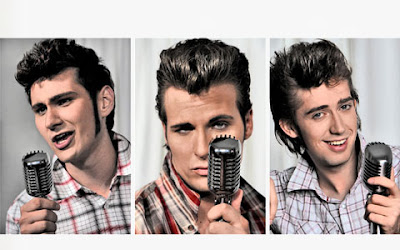By Annika
In 1969, the cover of the Beatles' recently released album
Abbey Road started a rumor that quickly spread through America. "Paul is dead." The theory was that on November 9, 1966, Paul McCartney stormed out of the recording studio, got into his car, and drove off. Soon after, he got into a car accident and died. Not wanting to make a big fuss, the remaining Beatles replaced him with the winner of a Paul McCartney look-alike contest, who, with a little plastic surgery, looked so much like Paul that nobody noticed.

Coincidentally, Paul's double can also talk and sing exactly like him. They were so much alike that nobody noticed that the real Paul was dead until three years later, when the Beatles released
Abbey Road.
The Evidence:
Some of the most substantial "evidence" was on the cover of
Abbey Road.
This scene was interpreted by some fans to be a funeral procession. In front, John is dressed in white, like a religious person. Next, Ringo is dressed in black, representing a mortician or a mourner. Paul, barefoot with a suit, would of course be the corpse. Lastly, George is wearing simple jeans, representing the grave digger. In addition, Paul is out of step. The license plate of the yellow VW bug is 28IF. This was interpreted to mean that Paul would be in his 28 year of life IF he were still alive.
Since Paul had died earlier than the release of
Abbey Road, previous albums also had clues, claimed the believers of this rumor.
On the back cover of
Sgt. Pepper's Lonely Hearts Club Band, Paul has his back turned to the camera.
In this picture, also included in
Sgt. Pepper's Lonely Hearts Club Band, Paul is shown sitting in the fetal position. This is how Indians bury their dead. The Beatles were known to be fascinated with the Indian culture. On his uniform, the white bars and epaulets are trimmed in black for death. Most shocking, however, is the patch on his left arm, which reads "O.P.D." In Britain, this means "Officially Pronounced Dead."
The Magical Mystery Tour came with a 24-page pamphlet full of pictures, many of which also have hidden "clues."
If one examines the drum closely, it is possible to read the words on the drum: "Love the 3 Beatles."
In this pictures, also included in the pamphlet, the Beatles all have red carnations. Except for Paul...his is black, symbolizing death.
In many of the pictures published with later albums, there is something about Paul that makes him stand out from the others, be it a black carnation, a different angle, no shoes, etc. Fans took these as "clues" telling them about his death. The list of evidence goes on and on. In addition, "deeper meanings" were found in some of the songs telling fans more about the death of Paul.
The Beatles denied accusations of having planted these clues either as a joke or to promote sales, so whether or not they did it purposely will remain a mystery.
If you would like to read more about the "Paul is dead" theory and the evidence, visit:
http://www.ispauldead.com/501.html
http://www.turnmeondeadman.com/index.php


















